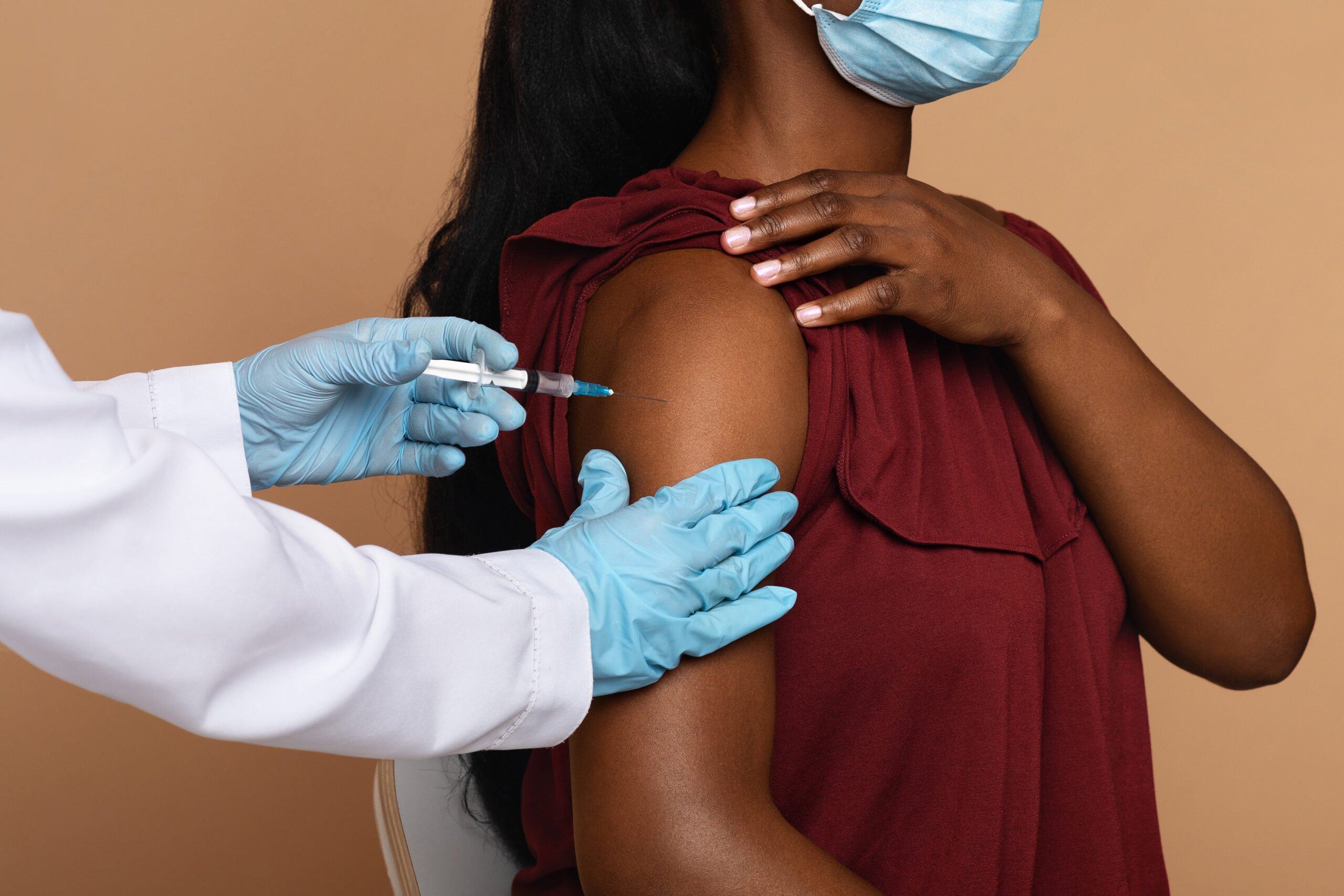Get Your Flu Shot At The ERC Clinic

What’s New for 2021-2022
A few things are different for the 2021-2022 influenza (flu) season, including:
- The composition of flu vaccines has been updated.
- All flu vaccines will be quadrivalent (four component), meaning designed to protect against four different flu viruses. For more information: Quadrivalent Influenza Vaccine | CDC.
- Licensure on one flu vaccine has changed. Flucelvax Quadrivalent is now approved for people 2 years and older.
- Flu vaccines and COVID-19 vaccines can be given at the same time.
- More detailed guidance about the recommended timing of flu vaccination for some groups of people is available.
- Guidance concerning contraindications and precautions for the use of two flu vaccines – Flucevax Quadrivalent and Flublok Quadrivalent – were updated.
Flu Vaccine
What is CDC's recommendation for getting a flu vaccine for the 2021-2022 flu season?
Annual flu vaccination is recommended for everyone 6 months and older, with few exceptions.
What viruses for the 2021-2022 flu vaccines protect against?
There are many different flu viruses, and they are constantly changing. The composition of US flu vaccines is reviewed annually and updated as needed to match circulating flu viruses. This season, all flu vaccines will be designed to protect against the four viruses that research indicates will be most common. Each year, the Food and Drug Administration’s Vaccines and Related Biological Products Advisory Committee (VRBPAC) makes the recommendation for the flu vaccine composition for US flu vaccines.
For 2021-2022, recommendations were made for egg-based, cell-based, and recombinant flu vaccines as listed below:
Egg-based vaccine composition recommendations:
an A/Victoria/2570/2019 (H1N1) pdm09-like virus;
an A/Cambodia/e0826360/2020 (H3N2)-like virus;
a B/Washington/02/2019- like virus (B/Victoria lineage);
a B/Phuket/3073/2013-like virus (B/Yamagata lineage)
Cell- or recombinant-based vaccine composition recommendations:
an A/Wisconsin/588/2019 (H1N1) pdm09-like virus;
an A/Cambodia/e0826360/2020 (H3N2)-like virus;
a B/Washington/02/2019- like virus (B/Victoria lineage);
a B/Phuket/3073/2013-like virus (B/Yamagata lineage).
These recommendations include two updates compared with 2020-2021 US flu vaccines. Both the influenza A(H1N1) and the influenza A(H3N2) vaccine virus components were updated. Compared with the Southern Hemisphere flu vaccine recommendation, this recommendation represents one update and that is to the influenza A(H3N2) component.
Will this season's flu vaccine match be affected by the low levels of flu virus activity last season?
All available flu vaccines in the United States this flu season are quadrivalent (four-component) flu vaccines that are designed to protect against the four flu viruses that research indicates are most likely to spread and cause illness among people during the upcoming flu season. In its role as a World Health Organization (WHO) Collaborating Center, CDC conducts year-round surveillance of circulating flu viruses and uses this and other data to assess population risk and to recommend the vaccine viruses to include in vaccine production for both the Southern and Northern Hemispheres. Flu viruses constantly change and, based on the available data on how flu viruses are currently changing, CDC flu experts anticipate that the flu viruses that circulate this season may have small changes in comparison to each of the four major virus components used in the vaccine. Despite these changes, the flu vaccine is still expected to provide good protection for the majority of flu viruses that are likely to circulate in the United States during the upcoming flu season. Since flu viruses change rapidly, some changes can result in decreased similarity between circulating viruses and one of the vaccine’s four components. The similarity of the vaccine’s four components to the flu viruses that circulated during previous seasons is just one of several types of data used to inform the recommendations for the composition of flu vaccines. Other data include the extent and location of flu virus circulation and the level of immunity in the population provided by the prior season’s vaccine against recent circulating flu viruses. CDC constantly reviews the composition of flu vaccines and suggests updates when needed to keep up with the latest flu viruses. Sometimes, updates to the composition of the flu vaccine represent minor, incremental improvements. Other times, the updates to the vaccine can represent more significant changes intended to provide optimal protection against flu viruses that have evolved to evade people’s existing immunity.
Do updates made to the composition of Southern Hemisphere flu vaccines mean that Northern Hemisphere flu vaccines are mismatched to circulating flu viruses?
In general, updates to the composition of Southern Hemisphere flu vaccines should not be interpreted to mean that the composition of Northern Hemisphere flu vaccines is mismatched to circulating flu viruses. The flu season occurs at different times in each hemisphere. Typically flu season lasts from October to May in the Northern Hemisphere and from April to September in the Southern Hemisphere. Decisions on the composition of flu vaccines must be made months prior to the flu season in each hemisphere so that flu vaccines can be produced and made available in time for the season. Since flu viruses are always changing, different flu viruses can circulate in different geographic areas of the world at different times of the year. As a result, separate recommendations are made for the flu vaccines produced in the Northern and Southern Hemispheres based on the data available at the time vaccine composition recommendations are made. The flu vaccines for each hemisphere are optimized to protect against the flu viruses that research indicates will circulate during the upcoming flu season in each hemisphere.
What does someone 65 or older do who is having trouble finding high-dose or adjuvanted flu vaccine?
Several flu vaccine formulations are approved for use in people 65 and older, including two “enhanced” flu vaccines: the high-dose flu vaccine and the adjuvanted flu vaccine, both of which are designed to create a stronger immune response in people 65 years and older. Also, a recent studyexternal icon showed that recombinant flu vaccine can produce a stronger immune response in people 65 years and older. Additionally, there are standard dose flu vaccines that can be used in people 65 and older. It’s important to note that CDC does not have a preferential recommendation for any flu vaccine over another, and vaccination should not be delayed for a specific vaccine product when another vaccine licensed for use in people 65 and older is available.
What if my vaccine provider doesn't have my preferred flu vaccine?
CDC recommends use of any licensed, age-appropriate flu vaccine during the 2021-2022 flu season, including inactivated flu vaccine, high-dose flu vaccine, adjuvanted flu vaccine, recombinant flu vaccine, and nasal spray flu vaccine. Vaccination should not be delayed for a specific vaccine product when another age-appropriate vaccine is available.
What is CDC doing to promote flu vaccination for the 2021-2022 flu season?
CDC has annual educational campaigns to increase awareness about the importance of seasonal flu vaccination. For the 2021-2022 season, CDC will continue to emphasize the importance of flu vaccination beginning in September and for the entire flu season. The agency will conduct targeted communication outreach to specific groups of people who are at higher risk for developing serious complications from flu. Communication strategies for providers and the public will include:
Educational outreach activities by CDC, including social media, press conferences, web page spotlights, radio media tours, op-eds, and other publications,
Special educational efforts and a digital campaign to inform the general population, people with underlying health conditions, and African American and Hispanic audiences about the importance of flu vaccination, and
Updated vaccination websites for the public and providers that highlight the safety precautions being implemented in health care facilities during the COVID-19 pandemic.
In addition, as part of its new Partnering for Vaccine Equity program, CDC is providing more than $150 million in funding to support national, state, local, and community-level partners working to increase confidence in COVID-19 and flu vaccines among adults in racial and ethnic minority groups.
I don't have a primary care provider. Where can I get a flu vaccine?
If you don’t have a health care professional you regularly see, you can find flu vaccines at many places, including health departments and pharmacies.
What is the best time to get my influenza vaccine?
September and October are generally good times to be vaccinated. Ideally, everyone should be vaccinated by the end of October. Adults, especially those older than 65, should not get vaccinated early (in July or August) because protection in this group may decrease over time. Children can get vaccinated as soon as vaccine becomes available—even if this is in July or August. Some children need two doses. For those children it is recommended to get the first dose as soon as vaccine is available, because the second needs to be given at least 4 weeks after the first. Early vaccination can also be considered for people who are in the third trimester of pregnancy, because this can help protect their infants during the first months of life (when they are too young to be vaccinated).
Flu Activity
Will new flu viruses circulate this season?
Flu viruses are constantly changing so it’s not unusual for new flu viruses to appear each year.
When will flu activity begin and when will it peak?
The timing of flu is difficult to predict and can vary in different parts of the country and from season to season. Reduced population immunity due to lack of flu virus activity since March 2020 could result in an early and possibly severe flu season.
Flu activity is low in my community right now; should I wait to get a flu vaccine?
No. You should not wait for flu activity to be rising or high in your community to get a flu vaccine. September and October are generally good times to be vaccinated and ideally, everyone should be vaccinated before the end of October. While flu activity may be low in your community now, it could begin increasing at any time. Remember, after you are vaccinated, your body takes about two weeks to develop antibodies that protect against flu. Ideally, you should get vaccinated against flu by the end of October.
Flu Vaccine Coverage
What vaccine uptake estimates will CDC provide this season?
CDC’s Weekly Flu Vaccination Dashboard provides preliminary, within-season, weekly influenza vaccination data which will be updated during the season as more data become available.
How many people have gotten a flu vaccine this season?
CDC’s Weekly National Influenza (Flu) Vaccination Dashboard provides preliminary, within-season, weekly flu vaccination data including coverage estimates throughout the 2021-2022 flu season. These data will be updated weekly or monthly, depending on the data source. All data are preliminary and may be updated during the season as new data become available.
How is CDC tracking weekly flu vaccination coverage among children 6 months - 17 years old?
Flu vaccination coverage among children is assessed through the National Immunization Survey-Flu (NIS-Flu), which provides weekly flu vaccination coverage estimates for children 6 months–17 years old. NIS-Flu is a national random-digit-dialed cellular telephone survey of households conducted during the flu season (October-June). Additional information about NIS-Flu methods and estimates from 2019-2020 season are available at FluVaxView.
How is CDC tracking monthly flu vaccination coverage among pregnant people?
Flu vaccination coverage estimates among pregnant people are available via CDC’s Weekly Flu Vaccination Dashboard. These estimates are based on electronic health record (EHR) data from the Vaccine Safety Datalink (VSD), a collaboration between CDC’s Immunization Safety Office and nine integrated health care organizations. Of note, because these estimates are based on data from nine integrated health care systems, they may not be representative of all pregnant persons in the U.S.
How is CDC tracking the number of flu vaccines administered at pharmacies and doctor's offices?
CDC is tracking the number of flu vaccines administered at pharmacies and doctor’s offices by utilizing new sources of vaccination data, including IQVIA data for vaccinations administered in retail pharmacies (e.g., chain, mass merchandise, food stores, and independent pharmacies) and doctors’ offices.
When will the first flu vaccine uptake estimates be provided for this season?
CDC’s Weekly Flu Vaccination Dashboard provides preliminary, within-season, weekly influenza vaccination data which will be updated during the season as more data become available.
Is this the same kind of vaccine uptake information that has been provided in the past? Is CDC working to improve flu vaccines uptake data?
Each flu season since 2009-2010, CDC has estimated annual flu vaccination coverage for the United States by utilizing data from several nationally representative surveys: the Behavioral Risk Factor Surveillance System (BRFSS), the National Health Interview Survey (NHIS), and the National Immunization Survey-Flu (NIS-Flu). Internet panel surveys of adults, health care personnel, and pregnant persons are also used.
Click here for vaccination coverage estimates from past flu season. CDC will continue to provide end-of-season estimates of flu vaccination coverage from these data sources.
CDC’s Weekly Flu Vaccination Dashboard, provides preliminary, within-season, weekly influenza vaccination data which will be updated during the season as more data become available. Visit the National Flu Vaccination Dashboard for more information. CDC continues to explore other sources of data to provide national and jurisdiction level vaccination data.
Seasonal Flu and COVID-19
What is the difference between flu and COVID-19?
Flu and COVID-19 are both contagious respiratory illnesses, but they are caused by different viruses. COVID-19 is caused by infection with a coronavirus (called SARS-CoV-2) and seasonal flu (most often just called “flu”) is caused by infection with one of many influenza viruses that spread annually among people.
Because some symptoms of flu and COVID-19 are similar, people may need to be tested to tell what virus is causing their illness. People can be infected with both a flu virus and the virus that causes COVID-19 at the same time. In general, COVID-19 seems to spread more easily than flu and causes more serious illnesses in some people. Compared with people who have flu infections, people who have COVID-19 can take longer to show symptoms and be contagious for longer.
Will there be flu along with COVID-19 in the fall and winter?
While it’s not possible to say with certainty what will happen in the fall and winter, CDC believes it’s likely that flu viruses and the virus that causes COVID-19 will both be spreading at that time. Relaxed COVID-19 mitigation measures (such as stay-at-home orders, or mask mandates) may result in an increase in flu activity during the upcoming 2021–2022 flu season. Common respiratory viruses such as respiratory syncytial virus (RSV) and human coronaviruses (not SARS-CoV-2) did not spread as much as usual during the 2020-2021 flu season as in past seasons. However, data from the National Respiratory and Enteric Surveillance System (NREVSS) showed an increase in these viruses’ activity during the summer, outside of their usual seasonal increases. This information is summarized in a Morbidity and Mortality Weekly Report, Changes in Influenza and Other Respiratory Virus Activity During the Pandemic.
Can I have flu and COVID-19 at the same time?
Yes. It is possible to have flu and other respiratory illnesses like COVID-19 at the same time. Health experts are still studying how common this is. Some of the symptoms of flu and COVID-19 are similar, making it hard to tell the difference between them based on symptoms alone. Diagnostic testing can help determine if you are sick with flu or COVID-19.
If I get sick with flu, am I at higher risk of contracting COVID-19?
Because COVID-19 is still a relatively new illness, we have little information about how flu illness might affect a person’s risk of getting COVID-19. We do know that people can be infected with flu viruses and the virus that causes COVID-19 at the same time. Getting a flu vaccine is the best protection against flu and its potentially serious complications, and getting a COVID-19 vaccine is the best protection against COVID-19.
Because symptoms of flu and COVID-19 are similar, how will I know if I have flu or COVID-19?
Your health care professional may order a test to help confirm whether you have flu or COVID-19 or some other illness. Get more information on COVID-19 and flu testing and symptoms of COVID-19 and flu.
Is there a test that can detect both flu and COVID-19?
Yes. There are tests that will check for seasonal influenza A and B viruses and SARS-CoV-2, the virus that causes COVID-19. Testing for these viruses at the same time gives public health officials important information about how flu and COVID-19 are spreading and what prevention steps people should take. These tests also help public health laboratories save time and testing materials, and possibly return test results faster.
Will a flu vaccine protect me against COVID-19?
Flu vaccines are not designed to protect against COVID-19. Flu vaccination reduces the risk of flu illness, hospitalization and death in addition to other important benefits.
Likewise, getting a COVID-19 vaccine is the best protection against COVID-19, but those vaccines are not designed to protect against flu.
Does a flu vaccine increase your risk of getting COVID-19?
No. There is no evidence that getting a flu vaccination raises your risk of getting sick from COVID-19 or any other coronavirus. (Common human coronaviruses usually cause mild to moderate upper-respiratory tract illnesses, like the common cold.)
I think I may have flu. Is it safe for me to visit my health care professional when COVID-19 is spreading in my community?
Health care professionals may have different practices for diagnosing and treating flu during the COVID-19 pandemic, such as wearing masks in a health care setting or offering telemedicine. If you have flu symptoms and are at higher risk of serious flu complications, you should call your health care professional as soon as possible to tell them about your symptoms. They may decide to treat you with flu antiviral medications. Follow your health care professional’s and CDC’s recommendations for doctor visits.
Getting a Flu Vaccine During the COVID-19 Pandemic
If COVID-19 is spreading in my community, should I still go out to get a flu vaccine?
Yes. Getting a flu vaccine is an essential part of protecting your health and your family’s health every year. Take recommended precautions to protect yourself from COVID-19 while getting your flu vaccine.
Do I need a flu vaccine if I wear a mask and practice physical distancing?
Yes. Wearing a mask and physical distancing can help protect you and others from respiratory viruses, like flu and the virus that causes COVID-19. However, the best way to reduce your risk of flu illness and its potentially serious complications is for everyone 6 months and older to get a flu vaccine each year. By getting a flu vaccine, you may also be protecting people around you who are more vulnerable to serious flu complications.
Can I get a COVID-19 vaccine and a flu vaccine during the same visit?
Yes, you can get a COVID-19 vaccine and a flu vaccine at the same time.
Even though both vaccines can be given at the same visit, people should follow the recommended schedule for either vaccine: If you haven’t gotten your currently recommended doses of COVID-19 vaccine, get a COVID-19 vaccine as soon as you can, and ideally get a flu vaccine by the end of October.
Is it safe to get a COVID-19 vaccine and a flu vaccine at the same time?
While limited data exist on giving COVID-19 vaccines with other vaccines, including flu vaccines, experience with giving other vaccines together has shown the way our bodies develop protection and possible side effects are generally similar whether vaccines are given alone or with other vaccines.
If you have concerns about getting both vaccines at the same time, you should speak with a health care provider.
Can I get a flu vaccine at the same time I get my COVID-19 booster shot?
Yes, you can get a flu vaccine at the same time you get a COVID-19 vaccine, including a COVID-19 booster shot.



